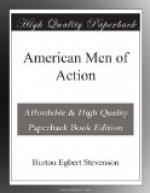Dewey had received his training under the best of masters, Farragut. Graduating from Annapolis in 1858, he served as lieutenant on the Mississippi, when that vessel, as part of Farragut’s fleet, ran past the forts below New Orleans. A short time later, in trying to pass the Confederate batteries at Port Hudson, the Mississippi ran hard and fast aground. Half an hour was spent, under a terrific fire, in trying to get her off; then Dewey, after spiking her guns, assisted in scuttling her and escaped with her captain in a small boat. He saw other active service, and got his first command in 1870. He was commissioned commodore in 1896, and on January 1, 1898, took command of the Asiatic squadron.
Few people in the world beside himself suspected, even in the dimmest manner, the task which lay before him; but with a rare sagacity, he had foreseen that, in the event of war with Spain, the far East would be the scene of operations of the first importance. He thereupon applied for the command of the Asiatic squadron, and his application was granted. Dewey proceeded immediately to Hong Kong, and began to concentrate his forces there and to get them into first-class condition. He spent much of his time studying the charts of the Pacific, and his officers noticed that the maps of the Philippine Islands soon became worn and marked. On Tuesday, April 26, came the explanation of all this in a cablegram stating that war had been declared between the United States and Spain, and ordering Dewey to proceed at once to the Philippine Islands and capture or destroy the Spanish fleet which was stationed there.
Early the next afternoon, the squadron started on its six hundred mile journey. What lay at the end of it, no one on the fleet knew. Of the Spanish force, Dewey knew only that twenty-three Spanish war vessels were somewhere in the Philippines; he knew, too, that they were probably at Manila, and that the defenses of the harbor were of the strongest description. But he remembered one of Farragut’s sayings, “The closer you get to your enemy, the harder you can strike,” and he lost no time in getting under way.
[Illustration: DEWEY]
Dewey’s squadron consisted of seven vessels, of which one was a revenue cutter, and two colliers. He was many thousands of miles from the nearest base of supplies and to fail would mean that he would have to surrender. So, on that momentous voyage, he drilled and drilled his men, until their discipline was perfect. On April 30, land was sighted, and precautions were redoubled, since the enemy might be encountered at any moment. Careful search failed to reveal the Spaniards in Subig Bay, and at six o’clock in the evening, Dewey announced to his officers that he had determined to force Manila Bay that night. At nine o’clock the fleet was off the bay, all lights were extinguished save one at the stern of each ship to serve as a guide for the one following, and even that light was carefully screened on both sides so that it could not be seen from the shore. Then the fleet headed for the harbor mouth.




